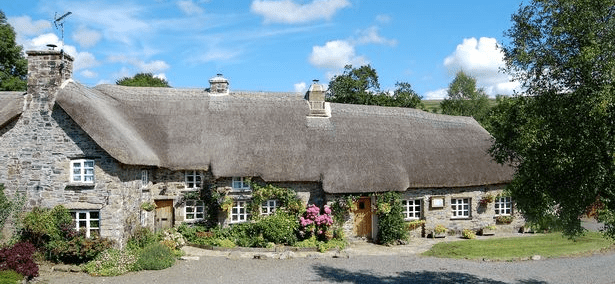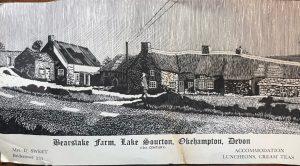Bearslake Inn, Sourton, Dartmoor

My goodness! What can’t you say about Bearslake Inn?
In 1955 Joe (Leslie) and Doris were driving around the area of Devon looking for somewhere to call home. They had 3 children still living at home – Margaret, John and Frank – and an urgent need to put a roof over their heads, with little money to do it. Joe had been building up a Delicatessen business in Taunton, and attracting plenty of local custom. It suited him as a connoisseur and seeker of fine foods, and infused with the flavours and foods he’d come to love during his time spent in Italy during the war. In 1955 a local rival pushed Joe into bankruptcy to take out the competition. Suddenly the family could no longer afford the upkeep and rental of their home in Dorset. They were looking for a “doer-upper” with enough of the basic services and roof to house the family and start again.
They came across Bearslake on such a trip. It was a run down, derelict building, looking sad and sorry for itself by the side of the road… but Joe and Doris, not to be defeated by a bit of hard work and determination, could see its potential. So in 1955, they bought Bearslake and set about building it up from ruin. The restored a 2nd storey for bedrooms, turned the 3 cottages into a single habitable home, put fresh thatch on the roof. The rooms were basic but with stone walls a foot thick and fireplaces so big you could stand inside them, it was warm and homely.
Joe worked as a travelling sales man, whilst Doris raised the kids and continued to restore and care for the now beautiful Bearslake.
It wasn’t long before a now restored Bearslake caught the attention of passing traffic – often Canadian ex service men keen to show their families the beauty of Devon and Dartmoor, and on route to visit Harrowbeer Airfield*, where they’d been posted for part of WW2. They would pull over by the side of the road to take photographs of the near perfect chocolate box cottage, nestled in a dip on the Okehampton to Tavistock road. Doris started to offer traditional Devonshire hospitality, a pot of tea, scones and cream, and suddenly a small cream teas business was formed. Doris made the clotted cream in a lean-to creamery, part of the barn at the end of the house. I remember seeing the huge round tins of clotted cream as a child! One of those tins (empty of cream) propped up my bed at home when the bed leg broke. Between Joe and Doris they set up tables and chairs on the grass outside the cottage, and eventually converted the barn into a tea shop. Later it became a pub and tea shop serving hot food in the evening and cream teas during the day.
What I love about Joe and Doris is just how entrepreneurial they were. Doris had a survivors instinct, having had a tough upbringing and survived 2 bombings of their home in Woking. In the midst of it, she’d raised 6 kids alone whilst Joe was serving in the RAF during the war. Joe had a mix of appreciation of every good thing he’d been exposed to in Italy, an open hospitable nature and a keen eye for a business opportunity.
Bearslake Inn has changed hands several times since Joe and Doris retired and moved to Hayle, in around 1980. It’s still serves food and those ramshackle bedrooms which used to house us as kids, sleeping on army-style camp beds side by side, 8 to a dorm, have been converted into more luxurious B&B accommodation, open to paying guests, and swept of all the spiders and mice which used to scamper across the thatch at night. Thanks to Joe and Doris, we had an amazing childhood, left to roam free on Dartmoor, learning how to stay safe when judging the terrain for treacherous bogs or how to find our way off the moor when the weather changed and the mists came down.

*RAF Harrowbeer sits between Plymouth and Tavistock. You’d have to drive straight past Bearslake Inn to reach it on the main road from Okehampton. The airfield’s runways were said to be built from the rubble of buildings destroyed in the Plymouth blitz in 1941. Polish and Czech pilots flew Spitfires from Harrowbeer. A squadron of the Royal Canadian Air Force began flying Mustangs from the airfield in 1943, followed by Typhoons and finally squadrons of Spitfires lined up to defend Britain from attack during D-Day.